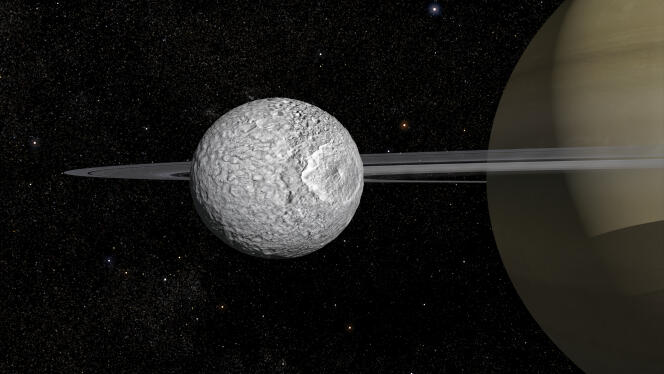


Despite being named after a giant from Greek mythology, Mimas is a rather small satellite of Saturn, measuring just 200 kilometers in radius. In the images available of the star, there's a ball of ice cratered to the extreme, with a hailstone surface that appears to have remained unchanged since the dawn of time. It may look like a dead star, but appearances can be deceiving. For, beneath the frozen crust, in the dark depths of this Saturn moon, complex activity led to the appearance of a subterranean ocean less than 25 million years ago – in other words, only recently, on the astronomical time scale, since the Solar System is over 4.5 billion years old.
Published in the weekly journal Nature on Wednesday, February 7, this discovery is the fruit of a lengthy analysis by an international team led by researchers at the Institute for Celestial Mechanics and Computation of Ephemerides (IMCCE), part of the Observatoire de Paris-PSL. More than a discovery, language purists would speak of evidence, a complex demonstration in two stages separated by a decade.
So let's go back 10 years to refer to an article, published by the journal Science in 2014, by what was more or less the same team. At the time, these researchers were wondering how to determine the internal structure of Mimas. To do so, "we went back to basics: celestial mechanics and Newton's laws," said Valéry Lainey, an astronomer at IMCCE and first author of the Nature study. The only clues available to scientists were the images taken by NASA's Cassini space probe, which tirelessly explored the Saturnian system between 2004 and 2017.
This was enough to study in detail Mimas's rotation and the small oscillations detected within it. To explain them, the 2014 paper put forward two hypotheses: either the satellite had a rocky core in the shape of a rugby ball or its ice shell was sliding over an internal ocean.
"We were frustrated not to know," admitted Lainey. "The overwhelming majority of scientists were convinced that Mimas was cold, frozen, uninhabitable, that there was no liquid ocean." But a conviction is not the same thing as solid proof. "We looked for a solution to distinguish between the two scenarios," continued the astronomer. They decided not to study the moon's rotation, but the subtleties of its orbital motion, again using Cassini data – in this case, tens of thousands of images.
The environment around Saturn is diabolically dynamic, with the giant planet's gravitational influence, its rings and its string of satellites all influencing one another. "The motion of Mimas is very disturbed," explained Lainey, "and the signal we were looking for was drowning in everything else." The researchers' model thus had to take into account no less than 19 moons.
You have 60% of this article left to read. The rest is for subscribers only.
